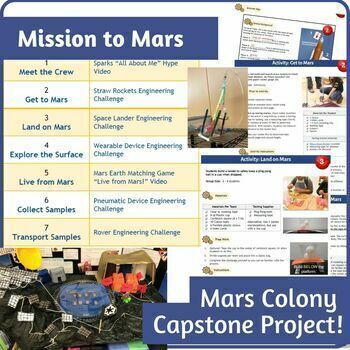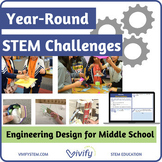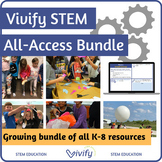Mission to Mars Semester STEM Unit + Mars Colony Project!
- Zip
What educators are saying
Products in this Bundle (5)
Also included in
- Space STEM Starter Challenges GROWING Bundle: Upper Elementary & Middle School STEMLaunch your students into STEM with these space-themed STEM challenges that incorporate the engineering design process. This mega bundle includes engaging STEM activities for space activities and design challengesPrice $226.72Original Price $283.40Save $56.68
- Are you in need of year-round STEM activities? This growing bundle includes our most popular STEM lessons and engineering design challenges for middle school grades! Click here for more guidance on planning out a STEM class including a scope and sequence and example STEM curriculum map. Includes a SPrice $388.52Original Price $485.65Save $97.13
- Are you in need of year-round STEM activities? This growing bundle includes ALL Vivify K-12 STEM lessons from team challenges, engineering design, semester-long STEM units, research projects, and more! Purchase everything for 20% off individual products! Here is a sample of what is included: Stage 1Price $990.24Original Price $1237.80Save $247.56
Description
Need a semester-long STEM unit? This Mission to Mars bundle includes engineering design challenges building up to a capstone project of building a habitat on Mars!
Lesson Overview
Transform your classroom into a team of astronauts on a Mission to Mars! This STEM curriculum begins with Stage 1 team challenges that build teamwork and communication skills. Mission Control then guides your class through Stage 2 engineering design challenges with each unit a progressively more complex design challenge as students arrive at and explore Mars. The final phase is to tackle the Stage 3 Mars Colony project.
Units are aligned to science and math standards along with a different career focus. Each session has an instructional video led by an engineer, editable handouts, and a complete teacher's guide.
Part 1: Mission to Mars
STEM curriculum includes 10 engineering and teamwork challenges:
- Meet the Crew: Mission Patch + Team hype video
- Get to Mars: Straw Rockets Engineering Challenge
- Land on Mars: Landing Device Engineering Challenge
- Exploring Mars: Wearable Device Challenge
- Live from Mars: Mars Matching Game + Live from Mars Report
- Collect Samples: Pneumatic Device Challenge
- Transport Samples: Rover Engineering Challenge
- Experiment on Mars
- Explore Mars: Catapult Challenge
- Emergency on Mars: Zipline Challenge
Part 2: Mars Colony Project
Design a colony on Mars! Take your STEM or STEAM classroom or program to the next level with this in-depth engineering design STEM challenge. Students will apply scientific concepts, math skills, critical thinking, research, and engineering design to plan a long term habitat on Mars. This creative and in-depth project is a great activity for your classroom or afterschool program! Students will need to consider questions like: How will colonists get food? What is the Martian environment like? Will our colony have a government? How do we prevent boredom? This product includes:
- Explore Mars: Teach students all about Mars through 5 interactive games and activities!
- STEM Project Guide: This complete project guide take students through the engineering design process to think about, research, design, and build a colony on Mars!
- Mission to Mars Planning Game: This Mission to Mars Planning Game product dives deeper into possible colony solutions, adds an interactive and game-like planning tool, and is especially useful for students that need more guidance, ideas for design solutions, or have limited internet access. Through game cards, students are introduced to real NASA technologies such as hydroponics, solar tents, MOXIE oxygen generator, and more! This encourages debate and consideration of budget and risk.
Looking for more STEM lessons? Our team of engineers and educators is dedicated to developing low-prep and high-quality STEM activities for any classroom! Click below to learn more:
- Vivify's Scope & Sequence + Standards Alignment
- Vivify's Resource Guide
- Learn about the 3 Stages of STEM
- Vivify STEM Membership
Customer Tips:
• Click the Green ★ to follow our store and get notifications of new products and freebies
• Leave feedback to receive TpT credit for use on future purchases
• Questions? Contact us in the Product Q&A section
♥ Connect With Us ♥
Email us: info@vivifystem.com








